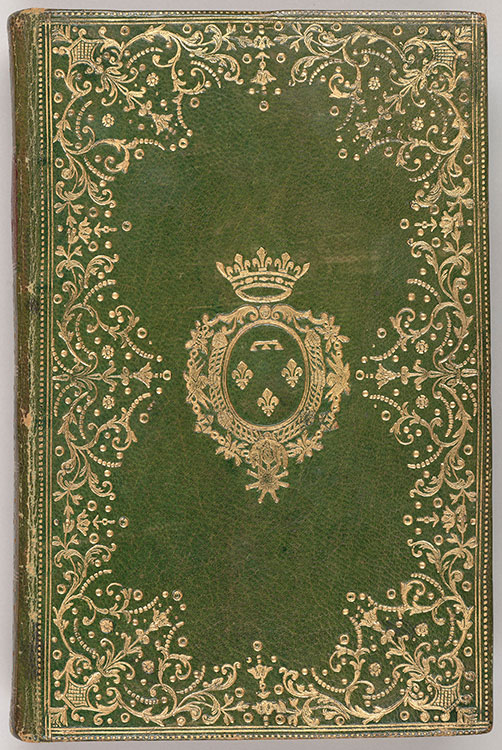The Art of Book Decoration
Finishing—the final phase of a bookbinder’s work—involves the ornamentation of the leather binding with an assortment of hand tools. The binder typically uses gold leaf, a thin gold sheet, which is laid over the book and impressed repeatedly with tools to pattern the cover—a process known as gilt tooling. The bookbinders of eighteenth-century France, influenced by the decorative styles of the times, advanced the art of finishing to new heights of ornamental luxury. This trend is evident in the work of the royal bookbinder (relieur du roi), of which three are of note: Antoine-Michel Padeloup (1685–1758), Pierre-Paul Dubuisson (act. 1746– 62), and Nicolas-Denis Derome (1731–1790). As masters of the craft, they could turn an inchoate set of materials—blank expanses of supple leather, gold leaf, and myriad decorative tools—into compelling and exuberant compositions.
The work of bookbinding was usually carried out in a binder’s workshop, or atelier, which employed a team of skilled assistants—male and female—to oversee the technical and decorative aspects of production. Attributing a binding to a specific atelier can be difficult, as bindings were infrequently signed and identifying tools were often shared within a family of binders. In the eighteenth century, an ever-growing number of book collectors and personal libraries expanded the bookbinding enterprise. Workshops became commonplace in and around Paris, and we know the names of many binders for whom there is no identified work. The bindings that survive from this age of plenty reflect both the skill of their creators and the fine taste of their collectors.
Bookbinding Terms

BOOKBINDING TERMS
MOROCCO LEATHER
A vegetable-tanned goatskin leather used in the finest bindings; produced in and procured from North Africa.
CORNERPIECE
A design element conforming to the corners of a binding, often matching the centerpiece or other decorative elements.
FLEURON
A stylized flower or leaf motif.
DENTELLE
A fine, decorative lacelike border that draws the eye to the center of a binding; created through a buildup of small tool impressions.
ARMORIAL
A heraldic decoration indicating ownership or affiliation; located centrally on a binding, it functions as the centerpiece.
CENTERPIECE
A design placed at the center of a binding.
POINTILLÉ
A series of small, hand-tooled dots.
LOZENGE
A diamond-shaped decoration.
FILLET
A plain, straight line or series of lines, usually around the outer edges of a cover.
Nicolas-Denis Derome (1731–1790), binding of green morocco, with gilt tooling and armorial, on Tarif des droits d’aides et autres y jointes, 1771. The Morgan Library & Museum; MA 23394.
Armorials and Individual Tooling


On the bindings at left and center, the binder had to take into account the size of the armorial when producing the dentelle. The two elements are not meant to compete but should instead form a single, cohesive composition. An ill-fitting armorial is a sign of poor planning or perhaps a later addition—as in the remboîtage, or repurposed binding, at right. This binding was removed from an unknown book, added on to a nineteenth-century text, then tooled with a large armorial that dominates and disrupts the initial, harmonious design. Hidden in each corner of the dentelle is an oiseau, or bird, the signature tool of the renowned original binder, Nicolas-Denis Derome.
Bound for Louis-Philippe I, duc d’Orléans (1725–1785)
Nicolas-Denis Derome (1731–1790), binder
Green morocco, with individual gilt tooling, on: Tarif des droits d’aides et autres y jointes, 1771
MA 23394
Remboîtage binding for Charles-Philippe, comte d’Artois (1757–1836)
Nicolas-Denis Derome (1731–1790), original binder
Red morocco, with individual gilt tooling and later armorial, on: Collection of Verse, 1821
MA 23404
Individual Tooling

The bindings displayed here are examples of intricate, well-planned design work. Decorative borders are symmetrical and necessitate detailed measurements and exacting tooling to ensure a balanced composition. The bindings have deep dentelles that both encroach upon and highlight the clean expanse of red morocco. Interstitial areas between fleurons and leaves are filled with pointillé and lozenge tools to create a more sumptuous design.
Red morocco, with gilt dentelle, in the style of Antoine-Michel Padeloup (1685–1758), on: Les amours pastorales de Daphnis et Chloé, 1718
PML 198330
Beyond Gold: Mosaic, Painted, and Foil Decoration



The mastery of gold leaf is but one skill in the binder’s decorative repertoire. Mosaic binding is another, more exacting finishing method. The inlay mosaic technique (seen on the first three bindings) involves cutting out a figural shape from the covering leather, then replacing it with an alternate piece of the same size and thickness but a contrasting color or grain. In the onlay technique, the contrasting leather pieces are laid over the covering leather, appearing in relief. Both methods can create elaborate decorative or narrative scenes.
The painted leather armorial is another decorative option, as seen on the fourth binding. The fifth binding combines cutout leather and gold and silver foil on a background of red foil. Sheets of mica, a clear silica material, protect the exposed painted areas and reflective foil.
Bound for Queen Marie Leszczyńska (1703–1768)
Jacques-Antoine Derome (1696–1760), binder
Mosaic binding in cream, black, and red morocco, with individual gilt tooling, on: Le psautier de David, 1725
PML 198290
Bound for an unidentified marquis
Perhaps Louis Douceur (d. 1769), binder
Red morocco, with individual gilt tooling and painted armorial, on: Pierre-Annet de Pérouse (1699–1763)
Extrait de l’histoire généalogique de la maison de Beaumont, 1757
PML 198348
Bound for Pierre-Louis-Paul Randon de Boisset (1708–1776)
Nicolas-Denis Derome (1731–1790), binder
Cut binding in cream and black morocco, with individual gilt tooling, and gold, silver, and red foil under mica, on: Almanach royal, année M. DCC. LXV, 1765
PML 198429
